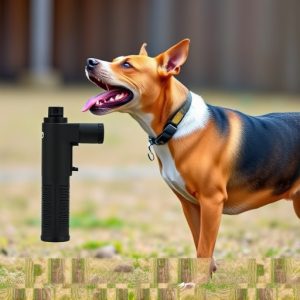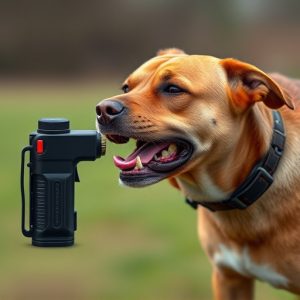Mace Canine Spray: Effective Deterrence with Legal Considerations
Dog deterrent sprays like Mace Canine Spray require understanding local laws regarding pattern width…….
Dog deterrent sprays like Mace Canine Spray require understanding local laws regarding pattern width, possession, and application to ensure responsible and legal use. Narrow patterns offer precise control, while broader ones provide faster coverage but may cause collateral damage. Mace Canine Spray stands out for its wide area of coverage, effective deterrence, non-stinging formula, and user-friendly design, making it ideal for homes and parks. Always follow manufacturer instructions, consider pattern width for precision, and be mindful of environmental impacts to promote responsible dog deterrence practices.
“In the quest for effective dog deterrence, especially during mail delivery, Mace Canine Spray has emerged as a popular option. This article explores the legal aspects of dog deterrent sprays, focusing on Mace’s unique features and its proven spray pattern width to ensure targeted and safe use. We delve into application techniques, safety precautions, and environmental impact, providing essential guidance for mail carriers and homeowners seeking a reliable solution to unwanted canine interactions.”
- Understanding Dog Deterrent Sprays: The Legal Perspective
- Mace Canine Spray: A Detailed Analysis of the Product
- Effective Use and Application Techniques for Optimal Results
- Safety Precautions and Environmental Considerations When Using Dog Deterrent Sprays
Understanding Dog Deterrent Sprays: The Legal Perspective
Dog deterrent sprays, commonly known as Mace canine spray, are designed to temporarily incapacitate or deter dogs from approaching or attacking. Understanding the legal perspective surrounding their use is crucial for responsible application and compliance with regulations. In many regions, dog deterrent sprays are regulated under specific laws that outline who can possess, carry, and use them, as well as where and how they can be deployed.
The pattern width of the spray mist plays a significant role in its effectiveness and legal considerations. Narrow patterns provide more precise control, reducing off-target effects, while broader patterns offer faster coverage but may raise concerns about collateral damage. It’s important for users to understand their local laws regarding dog deterrent sprays, including restrictions on where and how they can be used, as well as any requirements for proper training and certification.
Mace Canine Spray: A Detailed Analysis of the Product
Mace Canine Spray is a popular choice among pet owners and professionals for its effectiveness in deterring dogs from unwanted behaviors, such as aggression or persistent barking. This spray is designed to be used responsibly and safely, aiming to disrupt and discourage dog behavior without causing harm. The product is known for its convenient size, allowing for easy storage and transport, making it a handy tool for various settings, from homes to parks.
One key feature of Mace Canine Spray is its impressive pattern width, ensuring that the spray reaches a wide area when activated. This broad coverage is crucial in deterring dogs quickly and effectively, especially in situations where a dog’s behavior poses an immediate threat or nuisance. The spray’s formula is designed to be non-stinging and non-irritating, minimizing any discomfort for both the target dog and those nearby. Additionally, its user-friendly design makes it accessible to a wide range of users, promoting responsible dog deterrence practices.
Effective Use and Application Techniques for Optimal Results
For optimal results with dog deterrent spray, understanding effective use and application techniques is key. Start by identifying the target areas where dogs are prone to enter or loiter. Spraying in a wide pattern ensures thorough coverage, typically aiming for a 3-5 meter radius around the protected area. The Mace Canine Spray should be applied in swift, even sweeps, covering all visible surfaces and potential entry points. A consistent and liberal application is crucial, especially during peak hours when dogs are most active.
Remember, the goal is to create an unpleasant experience for the dog without causing harm. Aiming for a light misting can help reduce overspray onto desirable vegetation or surroundings. Practice good hygiene and store the spray out of reach from children and pets. Regularly test areas treated with the spray to ensure its effectiveness and refresh as needed, especially after rainfall or heavy winds.
Safety Precautions and Environmental Considerations When Using Dog Deterrent Sprays
When using dog deterrent sprays, such as Mace Canine Spray, safety precautions are paramount. Always follow the manufacturer’s instructions and ensure that the spray is designed for canine deterrence, as not all pepper sprays are effective or safe for animals. Keep these products out of reach of children and pets, and wear protective gear during application to prevent direct contact with skin or eyes. The spray pattern width should be considered too; a narrow stream is more precise and can help minimize off-target effects on the environment and bystanders.
Environmental considerations are also crucial. These sprays can have an impact on air quality and local ecosystems if not used responsibly. They may harm plants, water sources, and beneficial insects. It’s important to use them in well-ventilated areas and avoid spraying near bodies of water or heavily vegetated areas. Additionally, be mindful of the climate; extremely hot or cold conditions can affect the spray’s effectiveness and potentially pose further environmental risks.
The approval of dog deterrent sprays like Mace Canine Spray offers a legal and effective solution for managing canine behavior. By understanding the product’s mechanics, application techniques, and safety precautions, users can ensure optimal results while minimizing environmental impact. The Mace Canine Spray’s specific pattern width further enhances its effectiveness, making it a valuable tool for those seeking to deter unwanted dog interactions. Remember that responsible use and adherence to legal guidelines are paramount when employing any dog deterrent method.


